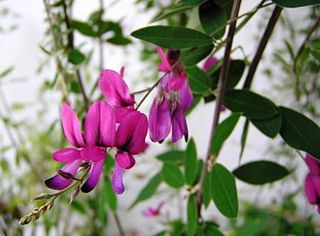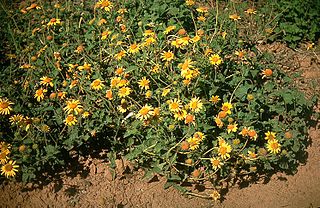
Clover or trefoil are common names for plants of the genus Trifolium, consisting of about 300 species of flowering plants in the legume or pea family Fabaceae originating in Europe. The genus has a cosmopolitan distribution with highest diversity in the temperate Northern Hemisphere, but many species also occur in South America and Africa, including at high altitudes on mountains in the tropics. They are small annual, biennial, or short-lived perennial herbaceous plants, typically growing up to 30 cm tall. The leaves are trifoliate, monofoil, bifoil, cinquefoil, hexafoil, septfoil, etcetera, with stipules adnate to the leaf-stalk, and heads or dense spikes of small red, purple, white, or yellow flowers; the small, few-seeded pods are enclosed in the calyx. Other closely related genera often called clovers include Melilotus and Medicago.

Clematis is a genus of about 300 species within the buttercup family, Ranunculaceae. Their garden hybrids have been popular among gardeners, beginning with Clematis × jackmanii, a garden standby since 1862; more hybrid cultivars are being produced constantly. They are mainly of Chinese and Japanese origin. Most species are known as clematis in English, while some are also known as traveller's joy, a name invented for the sole British native, C. vitalba, by the herbalist John Gerard; virgin's bower for C. terniflora, C. virginiana, and C. viticella; old man's beard, applied to several with prominent seedheads; leather flower for those with fleshy petals; or vase vine for the North American Clematis viorna.

Bidens is a genus of flowering plants in the aster family, Asteraceae. The common names beggarticks, black jack, burr marigolds, cobbler's pegs, Spanish needles, stickseeds, tickseeds and tickseed sunflowers refer to the fruits of the plants, most of which are bristly and barbed, with two sharp pappi at the end. The generic name refers to the same character; Bidens comes from the Latin bis ("two") and dens ("tooth").

Artemisia is a large, diverse genus of plants with between 200 and 400 species belonging to the daisy family Asteraceae. Common names for various species in the genus include mugwort, wormwood, and sagebrush.

Ceanothus is a genus of about 50–60 species of nitrogen-fixing shrubs and small trees in the buckthorn family (Rhamnaceae). Common names for members of this genus are buckbrush, California lilac, soap bush, or just ceanothus. "Ceonothus" comes from Ancient Greek: κεάνωθος (keanōthos), which was applied by Theophrastus to an Old World plant believed to be Cirsium arvense.

Coreopsis is a genus of flowering plants in the family Asteraceae. Common names include calliopsis and tickseed, a name shared with various other plants.

Helianthus is a genus comprising about 70 species of annual and perennial flowering plants in the daisy family Asteraceae commonly known as sunflowers. Except for three South American species, the species of Helianthus are native to North America and Central America. The best-known species is the common sunflower, whose round flower heads in combination with the ligules look like the Sun. This and other species, notably Jerusalem artichoke, are cultivated in temperate regions and some tropical regions as food crops for humans, cattle, and poultry, and as ornamental plants. The species H. annuus typically grows during the summer and into early fall, with the peak growth season being mid-summer.

Lespedeza is a genus of some 40 species of flowering plants in the pea family (Fabaceae), commonly known as bush clovers or Japanese clovers (hagi). The genus is native to warm temperate to subtropical regions of eastern North America, eastern and southern Asia and Australasia.

The Gnaphalieae are a tribe of flowering plants in the family Asteraceae. It is most closely related to the tribes Anthemideae, Astereae, and Calenduleae.

Phoradendron is a genus of mistletoe, native to warm temperate and tropical regions of the Americas. The center of diversity is the Amazon rainforest. Phoradendron is the largest genus of mistletoe in the Americas, and possibly the largest genus of mistletoes in the world. Traditionally, the genus has been placed in the family Viscaceae, but recent genetic research acknowledged by the Angiosperm Phylogeny Group shows this family to be correctly placed within a larger circumscription of the sandalwood family, Santalaceae.

Astereae is a tribe of plants in the family Asteraceae that includes annuals, biennials, perennials, subshrubs, shrubs, and trees. Plants within the tribe are present nearly worldwide divided into 170 genera and more than 2,800 species, making it the second-largest tribe in the family behind Senecioneae. They are found primarily in temperate regions of the world.

Viguiera is a genus of flowering plants in the family Asteraceae. The name honours French physician L. G. Alexandre Viguier (1790–1867). It contains around 150 species, which are commonly known as goldeneyes and are native to the New World. These are herbs to bushy shrubs that bear yellow or orange daisy-like flowers.

Calamovilfa is a genus of North American plants in the grass family native to the United States and Canada.

Orbexilum, commonly called leather-root, is a genus of flowering plants in the legume family (Fabaceae). They are native to North America, where they are found in the United States and Mexico, south to Chiapas.

Simsia is a genus of flowering plants in the tribe Heliantheae within the family Asteraceae. It includes annuals, herbaceous perennials, and shrubs. They range from the western United States south through Central and South America to Argentina, with the center of diversity occurring in Mexico. The genus is named for British physician and botanist John Sims (1749–1831). Although some species are relatively rare, others have become common weeds that line the roadsides and fields of Mexico, often forming dense stands mixed with Tithonia and other Asteraceae. Some species are known by the common name bushsunflower.

Acmispon is a genus of flowering plant in the family Fabaceae (legumes), native to North America and the west coast of Chile in South America. It includes several species of American bird's-foot trefoils and deervetches formerly contained in the globally distributed genus Lotus. The former genus Syrmatium is included in Acmispon. The Jepson eFlora accepts only Acmispon.

Cyclachaena xanthiifolia, known as giant sumpweed, or rag sumpweed is a North American plant species in the sunflower family, Asteraceae. It is the only species in the genus Cyclachaena. Giant sumpweed is believed to be native to the Great Plains but is now found across much of southern Canada and the contiguous United States, though rarely in the Southeast.

Calyptridium is a genus of flowering plants belonging to the family Montiaceae.
Gonzalezia is a genus of flowering plants belonging to the family Asteraceae.


















